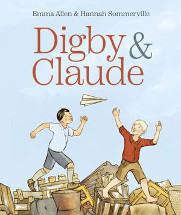Digby and Claude by Emma Allen

Ill. by Hannah Sommevillee. National Library of Australia, 2018.
ISBN 9780642279279
(Age: 7) Recommended. Themes: Australian History, Development,
Heritage, Architecture, Housing. The change that came across
Australian suburbs in the 1030's with clearing away of slums and
abandoned buildings is shown here through the story of two young
boys, Digby and Claude. They have an ideal life of roaming freely
through their neighbourhood, of claiming a small patch of land with
a wonderful old tree as their play space, of dragging all sorts of
discarded materials to make their cubby house extend up into the
tree. As the boys build their tree house, they watch the
redevelopment project across the road, of slums being demolished and
low cost housing being built in its place. Claude's father prevents
his son coming to the site because of the danger posed by the trucks
and diggers. When summer arrives so do the families and their
children, and Digby welcomes new friends to his tree house. And in
the tree, he tells the newcomers stories of days long ago when a
friend called Claude helped build the tree house.
This is a warm and enveloping story about the place where you
belong, a story of memories that build up around your own place,
that place called home. Digby and Claude together build their own
place and stock it with memories that they share, and when Claude
goes, Digby recalls those memories with others, sharing his place
with the newcomers. The contrast with the rebuilding over the road
reinforces the idea of home, how each new generation builds their
own memories and stories about their own place. Buildings come and
go but the stories remain.
The illustrations, redolent of images found in books and annuals
published for children between the wars, recreate the carefree and
innocent lives of children where they had the freedom to imagine and
build a tree house, meeting their friends there for the days with
nothing to do but play and chat and build, while in the background
we see the changes in the skyline of the suburb.
Several pages after the end of the story are devoted to a time line
of housing in Australia which will give readers an idea of the range
of housing in Australia from early times, and will encourage them to
look further. A page is devoted to a newspaper article outlining the
Erskinville development one of the first of its type in Australia, a
small cohort of low rental flats for families with children.
An interesting read, Digby and Claude could be used in conjunction
with the iconic "My Place" (Nadia Wheatley) which shows the changes
in Australia over time, through the life of one tree and the lives
of those around it, both books extolling the idea of home. Teacher's
notes are available.
Fran Knight